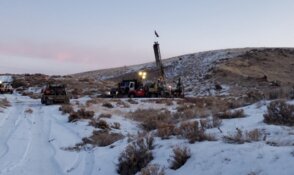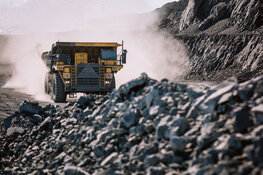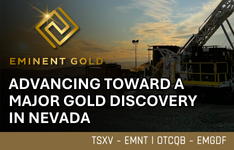Byron King: Whiskey and Gunpowder is a free newsletter from Agora Financial featuring select articles from Outstanding Investments or Energy and Scarcity Investor, along with guest essays from some of today's top economic minds.
It's good to mention Whiskey and Gunpowder because the idea is that readers would eventually take a look at Outstanding Investments, which is a lower-cost newsletter as opposed to Energy and Scarcity Investor, which is quite a bit more expensive. But in today's interview, we're going to give people some samples of the really good stuff.
TGR: Let's start with gold. The Hill, an online website covering politics, reports that Republican Congressman Ron Paul plans to introduce legislation that would force a mandatory annual audit of the American gold reserves at Fort Knox and the New York Federal Reserve bank. Paul said there is "a possibility that there might not actually be any gold at Fort Knox." What impact could that sort of audit have on the gold price?
BK: It's long overdue because, aside from taking the word of a few federal managers, nobody really knows what is inside Fort Knox. This is not lunatic conspiracy-theory thinking. This is prudent financial and asset management of an important component of the U.S. national monetary base.
We have this big granite vault in Kentucky, called Fort Knox. It's supposed to have the national gold reserve, which for the most part, was accumulated in the 1930s when President Franklin D. Roosevelt confiscated gold from the American people. That gold paid for the Second World War, the Cold War, Vietnam, and it paid for big government. Now the question is: What's in Fort Knox, and what is the quality of the gold?
TGR: But what impact would it have on the gold price?
BK: It could have two different impacts. If they open the doors to an independent third-party audit and it came back that everything is there and it's of a certain quality, then that would calm the markets. I actually think you could see the price of gold pull back a little bit. But, if a true and honest independent audit found that there's not as much gold as we thought or that—God forbid!—there's no gold, because it was all leased out by the Federal government, that would not be a good day for the U.S. dollar. And it would not be a good day for Federal fiscal managers.
TGR: We're talking about $350 billion in gold.
BK: It had better be there, because that's what they're telling the world. If it's not there, there's a problem. Bad news does not improve with age. I think that the gold reserve at Fort Knox is as important as our nuclear weapon stockpiles.
Audit the reserve. Give an honest assessment to the American people and move on.
TGR: Bangladesh recently bought $400 million in gold from the IMF. Should gold investors be concerned the IMF is liquidating its gold assets, or should they be heartened by the fact that a third world country like Bangladesh is bolstering its gold reserves?
BK: Some of both. I think it's a concern that the IMF, apparently, doesn't understand what gold is. It reveals that economic thinking at the highest levels of world monetary governance still treats gold as another commodity like hog bellies or orange juice futures. Within those high ethereal realms of international monetary management, people still don't understand that gold is money. I think it's good that Bangladesh has the funds to buy gold to put in its reserves. I think a generation from now, Bangladesh will erect a statue to whoever made that decision.
TGR: What's your investment thesis when it comes to gold?
BK: My standard investment thesis is that you should never put everything in one play. What I tell people is that, in a normal everyday portfolio, you should have about 10% of your portfolio in gold and silver—the physical stuff, the Real McCoy. That's before you start buying gold mining stocks or shares in a gold exchange traded fund (ETF). If 10% is not enough for you, then buy more. Buy more until you sleep well.
TGR: What's your personal asset mix?
BK: I don't brag about it because I don't think people should brag about what they own. Let's just say that I eat my own cooking. I own gold, I own silver. . .the Real McCoy. Just last week, I was out west visiting different sites when I stopped in Virginia City, Nevada and bought more silver ingots. When you walk into a store and they have beautiful silver ingots on sale, you should never walk out empty-handed.
TGR: Do you include precious metal equities as part of that mix?
BK: Oh, yes. Over and above the physical metal, I'm a great believer in gold miners—the big guys: Goldcorp Inc. (NYSE:GG; TSX:G) and AngloGold Ashanti Ltd. (NYSE:AU; JSE:ANG; ASX:AGG; LSE:AGD). Those are great companies.
Then there are the smaller Canadian juniors. A very nice precious metal miner that I just added to the Energy and Scarcity Investor list is Scorpio Mining Corp. (TSX:SPM), which has an operation in Mexico. I've met CEO Peter Hawley. He has really built a solid-producing precious metal company. He has an undergrad degree in mine engineering and a graduate degree in geology. It's the best of both worlds; this is the kind of guy you want running your silver-gold-lead-zinc mine. The base metals basically pay for the mine, so the silver is almost free.
TGR: I don't think many folks have even heard of Scorpio.
BK: One of the attractions of the company was that it didn't have a lot of exposure. It doesn't have a long track record behind it so that everybody's bought in. At the time I recommended Scorpio, which was in July, the company still had a lot of upside. It's done well in the last couple of months. I think there is still some upside left before the stock goes fully valued. Scorpio's already profitable. My God—a junior producer that actually makes a profit. Can you believe that?
TGR: Are there other small precious metal exploration plays that you're following?
BK: There's a wonderful play going on in the Yukon, in the old Keno Hill Silver District. It's being run by Alexco Resource Corp. (TSX:AXR; NYSE.A:AXU). Alexco is an excellent play; the company started out in environmental remediation. This environmental remediation company acquired the rights to these silver-mining claims left over after decades of mining. The company agreed to clean up the mess, but part of the contract said that Alexco could also mine the silver in the process of cleaning up.
This is an area that hadn't been looked at since the 1950s and 1960s. When Alexco went back there with modern exploration techniques, it found a whole lot more silver. I have seen some of the ore, and it is some of the highest-quality lead-zinc silver ore that you could find anywhere.
Alexco had some problems during the market crash, but it later sold some silver forward to Silver Wheaton Corp. (NYSE:SLW; TSX:SLW), a silver royalty company, for $50 million. The company used that cash to finish building the mine. By about November or December, Alexco's going to be "crunching" the first ore.
TGR: And you're a trained geologist. You know the difference between average drill core and something special.
BK: Yes, I got my geology degree at Harvard. My focus was actually hard rock geology with lots of mineralogy and petrology. I appreciate a good ore body when I see one.
I love the Alexco story. There's still a lot of upside because, once the company starts producing and has some cash flow, the institutions that can't invest in junior developers will begin to invest in a producer.
TGR: Gold has climbed 17% this year and outperformed all kinds of things—equities, Treasuries and most industrial metals. What are your thoughts on silver as a commodity and as an investment?
BK: You do need to look at both sides of the coin on silver. Silver is a monetary metal. People have used silver as a monetary mechanism for 4,000 years, maybe more. As gold does well for world fiscal reasons, silver also gets dragged along. That's part one. Part two is—the world is still using a lot of silver. Think about how many new electronic applications there are. Then there are the medical applications. You've got companies like Johnson & Johnson putting small amounts of silver in Band-Aids. It's a small amount of silver, but the company makes a lot of Band-Aids. I don't think we have to worry too much about the industrial side of silver.
TGR: How high do you think it can get by the end of 2011? We're right around $22 right now.
BK: We're around $22 on the quoted markets, but go out and try to buy an ounce of physical silver for $22. You can't. You're going to pay $25–$26 per ounce for the physical pieces of silver.
How high can silver go? It's already at $25 in a practical sense. As more and more people begin to realize the utter hopelessness of the U.S. government's financial situation, I anticipate more people fleeing to silver. It's the poor man's gold. If you can't afford the $1,350 to buy a Gold Buffalo coin, maybe you can buy $500 or $600 worth of silver and put it in a safe deposit box.
TGR: What are some silver plays out there that could see share-price appreciation if silver runs higher?
BK: My favorite big miner is Hecla Mining Co. (NYSE:HL) of Coeur d'Alene, Idaho. What I really like about Hecla is that it owns one of the largest, most important base metals and silver mines in North America. It's called Greens Creek and it's in the great state of Alaska. Greens Creek is a very long life mine. About two years ago, Hecla bought the share of the mine it didn't own from Rio Tinto Ltd. (LSE:RIO; NYSE:TP; ASX:RIO). It now controls the mine completely, which produces so much lead and zinc that Hecla actually gets paid to mine the silver—its cash costs for silver at Greens Creek are negative.
Hecla had problems during the market crash, mostly due to leverage. Part of that leverage was from buying out Rio Tinto and Greens Creek. But Hecla is not just a one-trick pony. It has incredibly good acreage in Idaho's silver district, as well as in south-central Colorado.
For environmental reasons, the last 30 or 40 years in the U.S. have not been kind to mining. Alaska's still a friendly jurisdiction; but, every time you turn around, environmental issues have hurt the mining industry. I think we're at a turning point. If the United States wants to be an important country in the future, we have to quit screwing around. We have to get back to basics. We have to get back to capital investments and making things, making important things. Great countries mine metals and minerals. The U.S. has a well-developed environmental industry, as well. I honestly think that it is possible to mine copper, lead, zinc, gold and silver and do it in a safe and environmentally responsible way.
Another way of playing rising silver prices is Silver Wheaton, which I mentioned earlier. That company has had an outstanding run since the market crash of 2008–2009. It was under $10 per share; now it's up in the high-$20s per share. How high can it go? If you think the price of silver is going up, then Silver Wheaton's share price is also going to go up. It has a very attractive business model. It has money, and you've got developers that need money upfront to fund development.
TGR: Are there some non-producers on your radar?
BK: Well, a wonderful play that is right on the cusp of breaking out is an explorer-developer working the Pinguino deposit in southern Argentina. It's called Argentex Mining Corporation (TSX.V:ATX; OTCBB:AGXM). I started looking at the company because its Pinguino property has lots of lead-zinc mineralization, and the zinc is rich in an element called indium—a critical metal for electronics. You can't do solar panels or flat screen TVs without indium. Argentex is really an indium play. This Pinguino deposit is among the highest-grade indium deposits ever discovered.
Argentex has an ongoing drilling program and plenty of money to fund it. The company has found that the lead-zinc ore also contains silver. A few weeks ago, it published a report announcing the discovery of over 3,000 grams per ton (g/t) silver in about a 40-ft.-long section of drill core. All of a sudden that turned this indium play into a silver play. You can now look at Argentex from two different directions.
One thing that people have been concerned about is that it's located in Argentina. Every time you read something about Argentina, it's bad. The other side of the coin is that Goldcorp just made a major investment in Argentina by buying out Andean Resources Ltd. (TSX:AND, ASX:AND). That's a $3.5 billion investment, so Goldcorp must think it can function in Argentina.
TGR: Let's change gears for a moment and head into rare earth elements (REEs) because you recently wrote a lot about REEs in Energy and Scarcity Investor. You said: "Over the next year or so, rare earths could be one sector—a tiny sector to be sure that's immune to the economic illnesses we're seeing in much of the rest of the economy." What makes REEs immune to the broader economy's ills?
BK: It's actually the small size of the sector that works in its favor. It is a physically and economically small sector in the global economy. The entire world output of all rare earths could fit on maybe two large iron ore carrying vessels.
Rare earths are exotic elements in the periodic table and the word is seeping out into the broader investment space about how critical these elements are to future technological applications.
Look for examples in Toyota Motor Corp.'s (NYSE:TM) Prius Hybrid. Every Prius battery has 33 pounds of an element called lanthanum, which makes the battery work. Or look at these windmills spinning away generating electricity. The permanent magnet inside a large, modern windmill uses about 550 pounds of an element called neodymium. Think about the thousands and thousands of windmills being erected. That adds up to a lot of neodymium.
TGR: There are really two types of rare earths, though, right?
BK: Yes, there are the heavy rare earth elements (HREEs) and the light rare earth elements (LREEs). You measure the lighter rare earths, like neodymium or lanthanum, in terms of tens of thousands of tons. There's a lot of that stuff, but it's still critical. It's not like the world has a massive surplus of it. Then you've got the heavy rare earths, things like europium or holmium—elements that are critical in electronic applications. You measure that stuff in kilograms, and it is far more valuable. But you use much less of it in the electronics.
On the supply side, China pretty much runs 95% of the global REE space and it has been lowering its REE exports steadily. China's more than happy to make the magnets and sell the magnets; but it's not exporting rare earths so you can make the magnets. The country wants to add as much value to the technological food chain as it possibly can—and do it in China because it creates jobs.
TGR: How did we let China get such a stronghold on the REE market?
BK: Because in the West, we pretty much let the REE industry go away. I mean the mine at Mountain Pass, California, has not mined ore since 2002. Molycorp Inc. (NYSE:MCP) just raised some money to do a major refurbishment of the Mountain Pass mine. The company actually has a business plan to get back into finished REE products, which I think is a good thing. The West has a lot of catching up to do. If the United States wants to be a serious country in the 21st century, we have to do rare earths because I think rare earths are a barometer of a country's willingness to devote resources to the frontiers of technology.
TGR: What are some REE plays that you're following that could possibly offset some of the supply constraints stemming from China's rule of the market?
BK: The one that I've been following the longest is an Australian company called Lynas Corporation (ASX:LYC), which has the Mount Weld mine in Australia. But the company's building an REE processing facility in Malaysia. It's a long story, but Malaysia offered a better deal.
Lynas had its problems in 2008–2009 when the banks bailed on it. The company had to raise a whole bunch of new capital, and it almost got taken over by a Chinese company. But I think the Australia government said: "We don't want the Chinese controlling this resource." So Lynas remains independent. It has a business plan and is working it.
Another play that I mentioned earlier, Molycorp, controls the Mountain Pass Mine in California. Mountain Pass was discovered in the days of the Cold War when people were looking for uranium. Uranium and thorium are quite commonly associated with rare earths. Mountain Pass supplied the baby boom with the europium that went into RCA color televisions.
The 1990s brought intense REE competition from China, and the economics got worse and worse. In 2002, a pipe broke and spilled thorium-laced material all over the California desert. Environmental regulators went ballistic. Unocal, the oil company that owned Mountain Pass, cleaned it up but it was still a bureaucratic mess.
Molycorp was owned by Chevron Corporation (NYSE:CVX) after Chevron bought Unocal. Chevron really didn't know what it had in Molycorp and let it set up as a private company.
A few months ago, Molycorp went public in the $13 range. It's around $27 now. I think the company has a really nice future ahead of it. It raised a bunch of money in the IPO, and it has a very good business plan called "Mines to Magnets." It's going to do everything, and then sell into a manufacturing chain. I met the CEO, and he knows his rare earths. He's one of the very few people in the West who really has a grip on REEs.
TGR: Are there some other smaller companies with a cheaper entry point?
BK: Well, the smaller—the riskier.
Another U.S.-based rare earth play that I'm looking at is Rare Element Resources Ltd. (TSX.V:RES). Its management team understands rare earths, and its Bear Lodge deposit in Wyoming is a nice deposit. Good mineralogy. Good future. It's a development play—nothing preordained or predestined about it. But in terms of the management team and the deposit, I think Rare Element has a good future.
An even smaller one that I'm looking at is called Ucore Rare Metals Inc. (TSX.V:UCU), which used to be Ucore Uranium. The company has a variety of projects in Canada and the U.S., but the one I really like is in Alaska. It's called Bokan Mountain, which is an old uranium mine; that means there are mining roads, a port facility, some infrastructure. They need to be fixed up but they're there. It's got a history of mining and permitting. It's in the middle of the Tongass National Forest, so there aren't people issues in terms of displacing residents. And the mineralogy is spectacular.
TGR: Earlier you mentioned giving Gold Report readers a taste of the good stuff. Can you share a morsel from your paid newsletters with our readers?
BK: Lara Exploration Ltd. (TSX.V:LRA); it's got the same management team as another company that I like called Reservoir Capital Corp. (TSX.V:REO). I like Lara. I'm going to be following Lara more closely and writing more about it, but I'm going to give the people who read my paid materials the first shot when I talk about Lara. But I like Lara, and I really like its management.
Look for Byron King's comments on the energy sector on The Energy Report, Byron King: Opportunities Across the Energy Spectrum.
Byron King writes for Agora Financial's Daily Reckoning and Whiskey and Gunpowder (a self-styled "independent investor's daily guide to gold, commodities, profits and freedom"). Byron edits two newsletters: Energy & Scarcity Investor and Outstanding Investments. He studied geology and graduated with honors from Harvard University and also holds advanced degrees from the University of Pittsburgh School of Law and the U.S. Naval War College. Earlier in his career, Byron worked as a geologist for Gulf Oil in the exploration and production division. He served for many years in both the active and reserve components of the U.S. Navy. Byron also, at a different time, practiced law, focusing on bankruptcy and other contentious matters involving people and money. Byron has written extensively about peak oil and world energy developments. His expertise includes precious metals and alternative energy sources, such as solar, wind and geothermal. Byron has also advised the U.S. Department of Defense on national energy policy.
Want to read more exclusive Gold Report interviews like this? Sign up for our free e-newsletter, and you'll learn when new articles have been published. To see a list of recent interviews with industry analysts and commentators, visit our Expert Insights page.
DISCLOSURE:
1) Brian Sylvester of The Gold Report conducted this interview. He personally and/or his family own shares of the following companies mentioned in this interview: None.
2) The following companies mentioned in the interview are sponsors of The Gold Report or The Energy Report: Goldcorp, Rare Element Resources, Ucore, Reservoir and Lara.
3) Byron King: I personally and/or my family own shares of the following companies mentioned in this interview: Goldcorp and Hecla (family). I personally and/or my family am paid by the following companies mentioned in this interview: None.













































